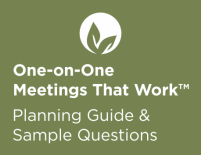
|
One-on-One Meetings That Work – Template Download
Early in my career, my boss recommended that I meet regularly with each of my direct reports. He knew it would both improve their productivity and improve my relationship and influence with my team members.
I thought it was a great
idea! And since I wanted the time to be as productive as possible, I
spent weeks trying to figure out how to structure the meetings and when
to schedule them.
Looking back – I wasted a lot of valuable time trying to set up the “perfect” meeting. Which was a futile effort from the outset – because I was going to be part of the meeting – and I’m far from perfect!
Let’s face it – we put off a lot of things that we should have started a long time ago. And we excuse our procrastination by calling it due diligence or planning.
Let’s call it what it is – fear, anxiety, laziness, inexperience. It
really doesn’t matter what we call it – just call it DONE! And get on with it!
So I did the one thing that I knew would get me going. I asked my assistant to put the One-on-One Meetings (O3′s) on my calendar.
I had two weeks to prepare for them. So, here’s what I did…PurposeI spent some time thinking about my purpose for the meetings. I also envisioned what my team members would like to accomplish in the meetings and what they would value most about our time together. Then I wrote it out -
To provide a structured time to coach my team members through the four components of effective leadership (life planning, business vision,
business planning, and priority management) and to fulfill one of my
core convictions – people are valuable and are worth developing
For more detail on this, be sure to download your FREE copy of my eBook, Creating Your Business Vision.
It includes tons of practical resources and a step-by-step guide for
developing vision for you, your team, or your organization.Regular time
Next, I scheduled biweekly,
30 minute appointments for each of my direct reports. I started out
biweekly because I wanted to be sure that the meetings wouldn’t be too
cumbersome by occurring too often without enough content.
I planned 30 minute appointments because you really have to be prepared to get through everything in 30 minutes. I wanted to make the most of our time together – so it was important to me that we structure the meeting to encourage both parties to come into the meeting prepared.Weekly or monthly meetings may work better for you and your team. In fact, my assistant and I meet twice a week for 30 minutes each time. Although we work together closely, the regularly scheduled appointments provide time to slow down and address top priority functions and projects. Use a Template – Download Now
Again, you don’t have to have it
all figured out right now. Just start with a simple plan for the meeting
that prepares you to listen.
To help me prepare for O3′s, I developed a One-on-One Meeting Template. It took months of tweaking to finally get my template into a format that was comfortable for me. You can save all that time and simply download it now by clicking here!
Be preparedPreparation is the key to an effective meeting! [Tweet That!]The more time I spend preparing, the more effective the meeting is for both of us. I spend approximately the same amount of time preparing for each meeting as I do in the meeting itself.
I review the meeting template and
questions prior to each meeting. I also review notes from our previous
meeting and the list of projects for the individual. Then I note the
specific questions I will ask. This provides a basic outline for the
meeting.
ListenYou will notice that the template is mostly questions – personal questions, project questions, resource questions, follow-up and feedback questions. This is by design – questions prepare me to listen!
And we need to listen to our teams far more than we do! Bill Greer, President of Milligan College, once said to me, If you want to help people, listen as long as you possible can before responding. [Tweet That.]
We simply cannot be effective if we’re waiting for them to shut up so we can start talking again.
These people are trading nearly
200 hours of their lives every month to be a part of what you are
building together – what you are becoming together. Are they trading
their time for something worthwhile? What are you going to give them
today that will change their life forever?
If you’re not ready to listen,
don’t schedule the meeting. Don’t waste your time and don’t waste their
time. Most team members are not interested in listening to their boss
talk for 30 minutes (or more). It’s likely they’ll simply sit across the
desk thinking about all of the work that you expect them to complete by
the end of the day!
When you ask your team more questions than you make demands, you’ll be more loved & respected. (Ben Reed)
During the meetingI have asked each of my team members to use the following agenda to help them prepare for each meeting. The following is one that I received from Building Champions executive coach Raymond Gleason.
Just as my preparation improves the meeting, when they are well-prepared, we both get a lot more accomplished.
Make notes and follow upThis is where many meetings fall apart – after the meeting is over.Mondays are my One-one-One meeting days – so my meetings are virtually back-to-back most of the day. However, I have scheduled 30 minutes between each meeting to process my notes and thoughts and prepare for the next meeting. I also scheduled an hour at the end of the day to wrap up anything I didn’t have time to complete during the day.
I take detailed notes in each
meeting on the meeting template form. After the meeting, I record
everything that was discussed in the meeting into a database. I use CoachBuilder Partner Edition from Building Champions. I note the action plans and due date for each that we agreed to. I list any items that I will followup with them between now and the next meeting. Then I email the team member their list of action items and due dates.
Since I began this process with
my team, I have seen remarkable improvements in each individual. And I
am improving! Our meetings aren’t perfect, but they’re far more
effective than they used to be.
Get StartedTo get started today, download the One-on-One Meeting Template. This template is the most searched item
on my blog from internet search engines and has been downloaded 1000′s of times since 2009.
It’s a simple form that you can use immediately to prepare for O3′s and
for taking notes while you’re in the meeting. The download also
includes tons of questions to plan O3′s for individual team members.
Question:
Tell us about your experience with One-on-One Meetings – Are you just
getting started? What’s working for you? What challenges have you faced?
Share your thoughts in the comments.
|
|
You just finished reading One-on-One Meetings That Work – Template Download! Consider leaving a comment on my blog.
|


No comments:
Post a Comment